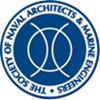Codesign Case Study of a Planing Craft with Active Control Systems
IF 1
4区 工程技术
Q3 ENGINEERING, CIVIL
引用次数: 1
Abstract
This case study presents a novel insight into the design of a codesigned planing craft with an active control system (ACS), along with its potential advantages and disadvantages when compared with a traditionally designed vessel (i.e., a vessel whose geometry is first selected, and then its ACS is implemented). This work has three purposes:present tools a designer can use to codesign a planing craft with its ACS,use these tools to expand the design space and further explore the potential of codesign, andinvestigate the feasibility of having a planing craft with ACS designed to the codesign results found in 2) and compare it with a traditionally designed vessel. The vessel particulars that are numerically optimized are the beam, dead rise, longitudinal center of gravity (lcg), and two tuning parameters for the ACS's linear quadratic regulator. In the case study, the codesigned vessel had 4% lower drag at the design speed and Sea State (SS) 3, but on lower SS's it had drag savings of 10% and seakeeping improvements of around 40% for the investigated seakeeping metric. The case study suggests that although the codesigned vessel is technically feasible, it would require unconventional hull/deck design—a result which emphasizes the importance of considering the coupling between a planing craft and its ACS early in the concept design. In search for a better performing planing craft, a naval architect could consider using an active control system (ACS) on their designs. Although they will encounter published research confirming performance improvements when an ACS is used (Wang 1985; Savitsky 2003; Xi & Sun 2006; Kays et al. 2009; Engle et al. 2011; Hughes & Weems 2011; Rijkens et al. 2011; Shimozono & Kays 2011; Rijkens 2013), literature addressing the concept design process of a planing craft that will have an ACS is, to the best of the authors' knowledge, limited only to the previous work by the authors (Castro-Feliciano et al. 2016, 2018). The work by Castro-Feliciano et al. (2016, 2018) suggests that the benefit from codesigning (as opposed to sequentially designing the vessel geometry and later adding an ACS) can be significant and should be the design methodology followed when designing a planing craft that will have an ACS.具有主动控制系统的规划船代码设计案例研究
本案例研究为具有主动控制系统(ACS)的协同设计滑行艇的设计提供了新的见解,以及与传统设计的船只(即,首先选择几何形状,然后实施ACS的船只)相比,其潜在优势和劣势。这项工作有三个目的:提出设计师可以用来用ACS对一艘滑行艇进行共同设计的工具,使用这些工具来扩大设计空间,进一步探索共同设计的潜力,并根据2)中的共同设计结果研究用ACS设计滑行艇的可行性,并将其与传统设计的船只进行比较。数值优化的船舶细节包括梁、死上升、纵向重心(lcg)和ACS线性二次调节器的两个调谐参数。在案例研究中,共同设计的船舶在设计速度和海况(SS)3下的阻力降低了4%,但在较低的SS下,所研究的耐波性指标的阻力节省了10%,耐波性改善了约40%。案例研究表明,尽管共同设计的船只在技术上是可行的,但它需要非常规的船体/甲板设计——这一结果强调了在概念设计早期考虑滑行艇与其ACS之间耦合的重要性。为了寻找性能更好的滑行艇,海军建筑师可以考虑在他们的设计中使用主动控制系统(ACS)。尽管他们将遇到已发表的研究,证实使用ACS时性能有所改善(Wang 1985;Savitsky 2003;Xi和孙2006;Kays等人2009;Engle等人2011;Hughes和Weems 2011;Rijkens等人2011;Shimozo和Kays 2011;Riijens 2013),但据作者所知,仅限于作者之前的工作(Castro Feliciano等人,20162018)。Castro Feliciano等人的工作(20162018)表明,共同设计(而不是顺序设计船只几何形状和后来添加ACS)的好处可能是巨大的,应该是设计具有ACS的滑行艇时遵循的设计方法。
本文章由计算机程序翻译,如有差异,请以英文原文为准。
求助全文
约1分钟内获得全文
求助全文
来源期刊

Journal of Ship Research
工程技术-工程:海洋
CiteScore
2.80
自引率
0.00%
发文量
12
审稿时长
6 months
期刊介绍:
Original and Timely technical papers addressing problems of shipyard techniques and production of merchant and naval ships appear in this quarterly publication. Since its inception, the Journal of Ship Production and Design (formerly the Journal of Ship Production) has been a forum for peer-reviewed, professionally edited papers from academic and industry sources. As such, it has influenced the worldwide development of ship production engineering as a fully qualified professional discipline. The expanded scope seeks papers in additional areas, specifically ship design, including design for production, plus other marine technology topics, such as ship operations, shipping economic, and safety. Each issue contains a well-rounded selection of technical papers relevant to marine professionals.
 求助内容:
求助内容: 应助结果提醒方式:
应助结果提醒方式:


